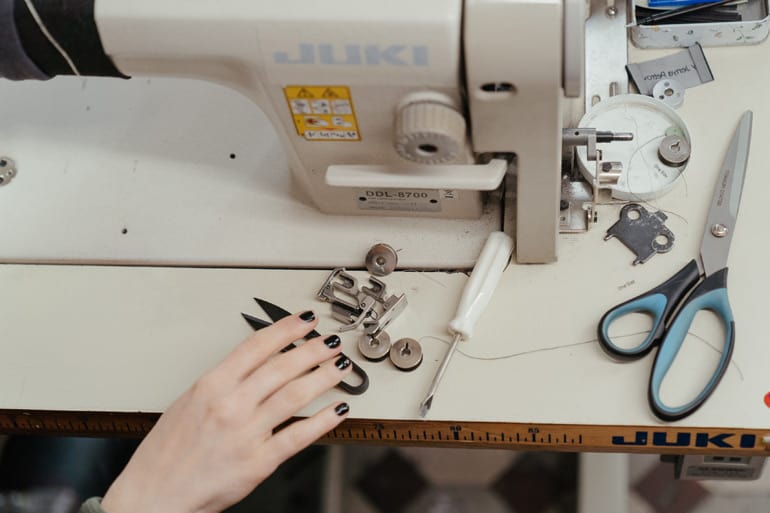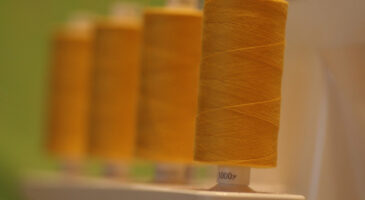As you work on your sewing machine, lint and dust get stuck within them, and if this is left to go on unchecked for a while, it’s only a matter of time before you start having difficulty using your sewing machine, hence the reason why cleaning is a matter of necessity. There are different ways sewers clean their sewing machine, but how long it will take depends on how dirty the machine is.
If you have seen sewist clean their machine before, you must have noticed that they always remove their sewing machine needle before cleaning.

You considered for a moment to wonder, what is the importance of removing the needle before attempting to clean the machine? Sorry, that’s not your headache, but the reason behind such practice is unraveled in this article.
Why do you need to remove the needle before attempting to clean the machine?
Sewists remove the needle from their sewing machine for one reason: safety purposes.
When cleaning, there is a possibility that the cleaner may accidentally press on the foot pedal or move the sewing machine handwheel, these two actions can move the machine needle, and if unluckily, the cleaner’s finger is under the needle at that moment, it may lead to a severe injury.
What do you think is the reason why we need to clean and keep the sewing machine?
Sewing leads to the accumulation of lint and dust, and when these impurities are not cleaned, eventually, they combine with the sewing machine oil to form oily grime. This oily grime is capable of rendering the sewing machine incapable.
Therefore, we clean our sewing machines to avoid this grime from ever occurring or to remove them, which will result in an uninterrupted flow of work and noiseless sewing.
What materials are needed to clean a sewing machine properly?
For you to properly clean your sewing machine, you will have to unfasten some components and also take some precautions to prevent work hazards, hence the reason why you will need some materials that are not related to conventional cleaning at all.
These materials are as follows;
- A bowl or container for soaking removed parts in the cleaning solution.
- Hammer
- Pairing knife
- Sewing machine oil
- Tweezers
- Small and large screwdrivers.
- Cleaning brush
- Fabric pieces
- Cleaning cloths
- Magnifying glass
- Replacement light bulb
- Sewing machine manual
What’s the sewing machine part that needs to be cleaned and lubricated?
Typically, your sewing machine has 3 main parts that have to be regularly cleaned. These parts are the presser foot, needle, and bobbin area.
How often to clean and lubricate a sewing machine?
Experts have different opinions as to when and how often to clean and lubricate a sewing machine.
The consensus is that sewists should endeavor to change and lubricate their sewing machine after they have changed the bobbin case up to 3 to 4 times.
For cleaning, it should be done after every 10 hours of use or just clean off lint when you notice they are starting to gather.
What is the first thing to do before cleaning the sewing machine?
The first step when cleaning your sewing machine is dusting the bobbin case. You can do this by using the little brush that comes with your sewing machine right from the factory or any small brush you can lay your hands on.
How do you clean a dirty sewing machine?
After getting all the materials listed above, you can then start to clean your sewing machine by following the steps below.
- Unplug it from the power source.
- Remove the needle and the presser foot from the sewing machine. If you do not know how to do this, please refer to your machine’s instruction manual.
- Remove the machine needle plate or throat using a screwdriver, pressure point, or tweezers and clean a brush.
- Remove the bobbin case as well and clean it with a brush. If there is too much lint in hard-to-reach corners, you can get rid of them using a vacuum or canned air. If you are using canned air, make sure you are careful not to push the lint into the machine further.
- If you notice an area with a stuck-on stain or dirt, dip a clean cloth in rubbing alcohol and rub directly on the stain to get rid of them.
- Go to your machine tension and run it with pearl cotton soaked in rubbing alcohol to get rid of possible stains.
- If you can remove some parts of the sewing machine head, please do so and clean them with a brush.
- Oil the machine according to the instruction manual, or you can check my previous post.
- Change your sewing machine light bulb.
- Couple all disassembled components of your machine. In case you are lost, your instruction manual is there to guide you through.
- Change your needle and run fabric pieces on the sewing machine to see if every part is working perfectly.
How will you observe proper handling and cleaning of the sewing machine?
- Always ensure that your sewing machine is properly oiled.
- Every week, make sure all exposed parts of the machine are correctly dusted.
- Ensure all integral components are well-oiled.
- See to it that you only make use of good quality sewing machine oil.
- Before oiling, make sure that every lint or any form of impurities is removed.
What is the safety procedures in the maintenance of sewing machine?
- Ensure your attention is focused on your hand and your work.
- Always make sure there’s a safe distance between your hand and the needle.
- When unplugging the machine, do it while holding onto the plug and not the cord.
- Make sure that your hands, scissors, or any other sharp objects are kept away from the belt.



